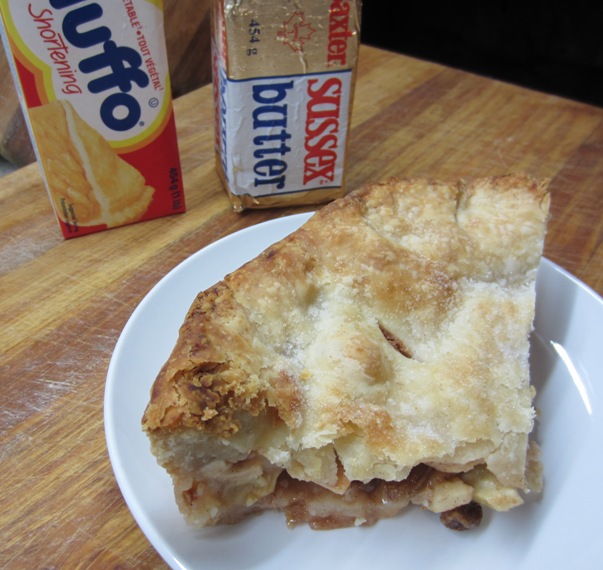Some online discussions cropped up about the ‘perfect’ pie crust so here’s my entry into the fray. Happy pie making out there you crust-obsessed whackos.
People still insist they can’t make a good pie crust. I make a lot of pies, especially this time of year when apples literally fall off the roadside and root veg comes in twenty kilo farmer’s sacks. Just about anything tastes good in a pie, sweet or savoury, as long as you wrap it in a great dough but of course what defines a pie is the crust. To all those out there who say they can’t make a good pie dough and resort to horrible ready-made versions in a box, I say practice, practice, practice. After making a few trials it’ll be faster (and better, and cheaper) than driving to the store.
There’s some real science to pie dough with ‘experts’ resorting to all manner of trickery. I’ve even seen vodka used because of the way it evaporates during baking. While their techniques may work, I don’t think you need them if you have a decent scale and a little experience under your belt. It really is the work of seconds if you have a food processor to start the method but nothing replaces simply trying your hand at the first dozen to get the finesse you need down pat.
Of course there are several types of crust from shortbread to graham cracker crumb but I’m talking about a stock standard pastry dough that can make apple or pork pies equally well. The fat-to-flour ratios are critical but I’ve already found those proportions that I know to work. Lucky you. All you need do is follow a few technique tricks that arise from using two different sorts of fat, mostly based on working temperatures. Butter lends flavour and shortening gives flaky texture. You can make dough from only one or the other but the ratios would need tweaking and you wouldn’t get the benefits each offer.
I’ve experimented with all manner of flours and always come back to simple all-purpose versions for the best results. Our Canadian made examples use ‘hard’ wheat and work like a charm but I suspect most any all-purpose you have locally will do well. Specialty flours like almond or oat can be added for subtle flavours but only up to about five percent of the mix before you need to re-engineer the whole affair. Bleached or unbleached doesn’t seem to matter with pie dough but of course don’t accidentally grab ‘self-raising’ versions unless you want the worst puff pastry ever. Whole meal (aka. whole wheat) would also be totally different chemistry at play so don’t be tempted unless you’re in a mood for lots of trial and error.
I start mine in the food processor but always finish by hand to prevent the dough from getting overworked. If you need to go completely manual it still works perfectly well but invest in a bladed pastry cutter to incorporate the fats or in a pinch use two knifes crossed against each other. Work as quickly as you can so the fats stay cold. See the technique in action in my chess pie video.
Perfect Pie Dough
Whether it’s sage-laden Canadian tourtiere with pork and potatoes, a giant samosa, creamy mushrooms & caramelized onion, chicken pot pie with heaps of vegetables, or old-fashioned apple, this pie dough will work for them all. Don’t cheat on the chilling stage if you want flaky results.
370 g all-purpose flour
1 teaspoon fine sea salt
1 tablespoon sugar (optional for sweet pies)
110 g vegetable shortening, well chilled and cut into 1/2″ pieces
170 g butter, well chilled and cut into 1/2″ pieces
6 tablespoons water, ice cold
Yield: Two 12″ pie crusts
Into a food processor add the flour, salt, and sugar and pulse twice to combine. Add the shortening and pulse just enough to make a granular texture, about four pulses, being careful not to over process. Add the butter and pulse further just until a coarse meal texture is achieved, about five pulses.
Turn out the mixture onto a lightly floured work surface and form a well in the centre. Add the water and, working quickly with a pastry scraper and your hands, form into a dough with as little kneading as possible. Split in half and form two discs. Wrap in cling film tightly and refrigerate at least thirty minutes before use. Can be used over the next two days fresh or frozen up to a month.
Roll out crusts from dough that has been brought to room temperature on a lightly floured surface using quarter turns between each rolling.

